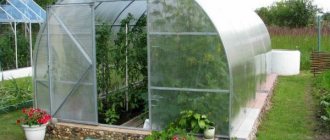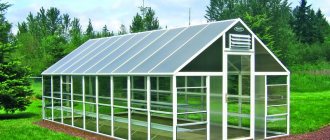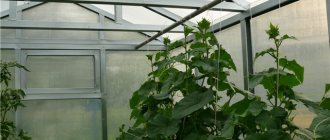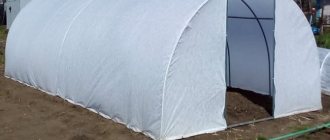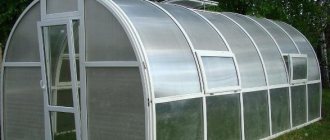For normal growth and development, plants need light, which may not be enough in winter. Lighting a greenhouse with your own hands is not an easy task, but it is a very real task if you know exactly what types of lamps are best used in summer and winter closed ground structures. To properly arrange the lighting, you need to make a drawing or use ready-made calculations to connect all the necessary devices.
Details of arranging lighting for greenhouses with your own hands with detailed calculations, photos and videos can be found in this article.
- Luminescent
- List of required materials and tools
Lighting ranges
Lack of lighting or poor quality artificial light can lead to plant death.
This is due to the fact that with a deficiency, the process of photosynthesis, on which the life and development of crops directly depends, is weak. With low sun consumption, the growth process will slow down, fertility will deteriorate, and cuttings and stems will unnaturally lengthen. Daytime natural light is the best lighting for plant life. Artificial greenhouse lighting can affect crops in a variety of ways. It can be divided into ranges based on wavelength:
- 320 nm – 400 nm – such lighting is required by plants in small quantities;
- 400 nm – 500 nm – blue is required for vegetative growth of vegetation;
- 500 nm – 600 nm – green is necessary for photosynthesis of the lower leaves;
- 600 nm – 700 nm – red illumination is necessary for photosynthesis during flowering;
- 700 nm – 750 nm – far red is required in small quantities;
- 1200 nm – 1600 nm – biochemical reactions are accelerated.
Vegetation reacts differently to each spectrum at a certain stage of its development. But during the entire life of the plants, the radiation must be complete and contain all colors. If any part of the radiation spectrum is missing, the harvest will be of poor quality.
Since lamps have not yet been invented that can completely imitate and replace solar lighting, it is necessary to combine several lamps.
Backlight time
For tomatoes, 8-10 hours of illumination is sufficient.
The quantity and frequency of illumination plays an important role. Fruit-bearing plants need more sun than those that produce edible foliage.
The following crops are considered short-day:
- zucchini;
- eggplant;
- tomatoes;
- peppers.
They need 8-10 hours of light.
The following plants need more than 12 hours:
- onion;
- garlic;
- dill;
- salad;
- cucumbers;
- cabbage;
- roots.
Before creating greenhouse lighting, you need to calculate the illumination in advance. High-quality lighting for vegetation will include several bulbs from different spectrums. Lamps should be installed in such a way that all plants receive light.
Lighting for different types of greenhouses
There are 3 types of greenhouses: polycarbonate, industrial and winter.
Polycarbonate is a high-quality covering material that is actively used in greenhouses. It has high light transmittance and is easy to maintain. Several types of lamps need to be installed in a polycarbonate greenhouse. The following greenhouse light is commonly used:
- incandescent lamps - they provide excessive radiation, which can negatively affect plants;
- mercury - additionally heats the room;
- sodium - characterized by high light output and a yellow-orange spectrum, favorable for plants;
- fluorescent - the best option for greenhouses, interact well with UV lamps;
- halogen - exactly repeat the spectrum of natural lighting;
- LED – provide high-quality blue and red light.
Industrial greenhouses use special lamps with high efficiency and high-quality light. Sodium light sources are usually used.
Winter is characterized by short daylight hours. Sunlight is becoming insufficient, so you need to choose the right lighting equipment. The main criteria are the duration and power of the backlight.
Industrial
Winter
Polycarbonate
It is important to take into account the area of the greenhouse. The light should be uniform throughout the greenhouse, so you can use lights with reflective reflectors. By type of light bulbs, mercury, sodium, fluorescent (ideal for winter lighting), metal halide, and LED sources are used.
How they work
A high pressure sodium lamp is not a very complicated design. This is a flask made of durable heat-resistant glass. Inside it is a cylindrical discharge tube, or burner. It is made of aluminum oxide Al2O3. This material is resistant to sodium vapor (with which the burner is filled) and the high temperature of the electric arc. In addition to sodium vapor, the tube contains amalgam (an alloy with mercury) and gas - xenon. It is sodium vapor that gives DNA its glow color – yellow-orange.
HPS cannot simply be connected to a 220 V network. This voltage is not enough for it. In addition, it is necessary to limit the arc current. Therefore, to turn on this lamp you need a ballast, or ballast (sometimes electronic or electromagnetic).
This same ballast is an inductive choke, a pulsed ignition device (IZD) and sometimes a phase-compensating capacitor. The power of the choke and IZU must correspond to the power of the lamp.
Lamp for plants DNAT assembled
There are different strengths of DNAT. But for illuminating plants, lamps from 70 to 400 W are suitable. For example: one 400-watt lamp can illuminate 1.2 square meters. m greenhouse.
Lamp options
It is not recommended to use incandescent light bulbs when growing plants. They have low efficiency, produce light that can negatively affect vegetation, and also do not last long.
Luminescent sources must be selected according to color temperature. The most affordable is cold light, suitable for background lighting. Warm color is used by flower growers. There are combination devices that combine the benefits of warm and cool colors. Great for night lighting.
Energy-saving appliances are small in size and convenient. They are used in conjunction with reflective reflectors.
Gas discharge lamps are represented by mercury, sodium and metal halide devices. They are used in professional greenhouses and are expensive. They have high light output and a spectrum favorable for vegetation. Metal halide sources imitate natural spring light and are used in the first phase of growth.
LEDs and LED strip for greenhouses are the most environmentally friendly and modern devices. They have high efficiency, long service life and require a small amount of electricity. You can make LED lamps for a greenhouse with your own hands.
Air circulation
Air circulation maintains an atmosphere of optimal humidity, temperature, and cleanliness in the greenhouse. An electric exhaust fan placed in one of the top corners of the greenhouse removes hot, moist air. The influx of fresh air comes from ventilation vents that are open for some time.
Conventional fans are used to move air and prevent stagnation, especially in winter. They maintain the room temperature and prevent plants from freezing.
Lighting for different crops
To grow cucumbers, the following rules must be observed in a greenhouse:
- the use of additional light when there is a lack of natural light;
- there should be no break between daylight and artificial light;
- period of darkness – 6 hours;
- temperature in artificial light +/- 8 degrees.
Onions need natural greenhouse lighting. Additionally, phytolamps are used.
To grow strawberries, you need meter-long fluorescent lamps with a power of 40-50 W.
The formation of strawberry inflorescences occurs during 14-18 hours of daylight. When additional light is used, fruiting occurs earlier and the harvest volume increases. In nature, it occurs during the spring-summer period.
Tomatoes require additional lighting with direct light. In the first days, the backlight is used for 20 hours, gradually reducing it to 16 and 12 hours.
Lighting is calculated using the formula F=E x S/Ki, where F is the required light flux, E is illumination, S is the greenhouse area, Ki is the flux utilization factor.
The importance of light for plants
Greenhouse plants, along with watering and fertilizers, vitally need light, which promotes the growth and fruiting of crops (Figure 2).
Note: The basis for the growth of any plant is photosynthesis - the process by which leaves absorb energy from the sun and transform it into oxygen. Thanks to this, the process of growth and expansion of green mass starts.
Each type of crop requires light of a certain intensity. For example, root vegetables or cabbage need it for 12 hours a day, while zucchini or beans will need only 8 hours for flowering and fruiting.
How much light is needed and what kind of light it should be
As mentioned above, each type of plant requires a certain intensity and duration of sunny days. Therefore, in the process of calculating lighting for winter structures, it is necessary to take into account the type of crops that will be grown indoors.
Figure 2. Effect of the sun on plant development
All garden crops are divided into several types, depending on the intensity and duration of light.:
- Long day - plants that need to be artificially illuminated for 12 hours a day to speed up the onset of flowering and fruiting. Such crops include garlic, onions, cabbage and most root vegetables.
- Short-day plants do not need intense light, so it is recommended to turn on the lamps only at certain times and for no more than 10 hours a day. Such crops include eggplant, zucchini, beans, tomatoes and bell peppers.
- Neutral plants are practically independent of the length of daylight and bloom regardless of the intensity of the sun or backlight. Such crops include roses, but if you want to maintain the health of the plants, it is recommended to turn on the backlight only at certain hours, strictly adhering to the schedule.
Natural sunlight is considered the best for plants, but if it is not enough (for example, in winter), you can use LED or fluorescent lamps.
Backlight requirements
All plants are by nature adapted to white sunlight, but it is quite difficult to provide similar lighting indoors, so it is recommended to use light in the red and blue spectrum, alternating them during periods of fruiting and vegetative growth (Figure 3).
When making calculations for winter greenhouses, you need not only to calculate the amount of energy required to provide all plants with light, but also to make a rough plan or layout of the lamps. This is necessary because different groups of plants require light of different intensities and durations.
What plants need and how much light?
All plants are divided into light-loving and shade-tolerant. Based on this, the lighting intensity is calculated.
All green crops, cucumbers, tomatoes and green onions require fairly intense light, and the day should be at least 10 hours long. Therefore, when growing such crops indoors, you need to adhere to a clear schedule to preserve the harvest in winter.
Figure 3. Organization of lighting in the greenhouse
Most types of flowers tolerate moderate shading well, which does not affect flowering. However, it should be borne in mind that it is impossible to illuminate the building with ordinary incandescent lamps, because they often fail and quickly heat up, disturbing the fragile microclimate of the greenhouse or greenhouse.
Electrification of greenhouses
The process of electrifying a greenhouse is not difficult even for a beginner. It consists of the following steps:
- creating a layout of greenhouses and lighting fixtures;
- calculation of footage of wires, distribution boxes;
- purchase of materials - cables, sockets, switches and other auxiliary devices;
- output of wires from the panel to the greenhouse;
- connecting wires to sockets.
Wires can be carried through ground or air. For correct, safe and reliable installation, a number of requirements must be met. The depth of the trench when laid underground must be at least 0.8 m, it must not intersect with the drainage system, and the cable itself must be protected by a corrugated pipe. When laying overhead, cables should not touch bushes and trees, as this can lead to wire breakage.
Particular attention should be paid to selecting the cable cross-section for lighting in the greenhouse. The calculation can be made using formulas that take into account power and current.
Precautionary measures
Before turning on electrical machines and tools in a metal casing, check their grounding. Electrical tools with a plastic coating are double insulated, but they are connected using a three-wire extension cord.
Do not use power tools in wet conditions. Do not leave cables on wet ground or lawns.
Before connecting to the network, check the connecting cables of all instruments. If the cable is damaged, this section is cut out and the ends are connected with environmentally resistant insulating tape.


